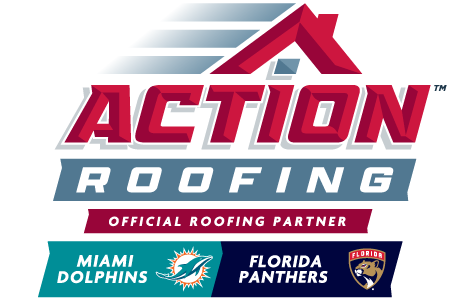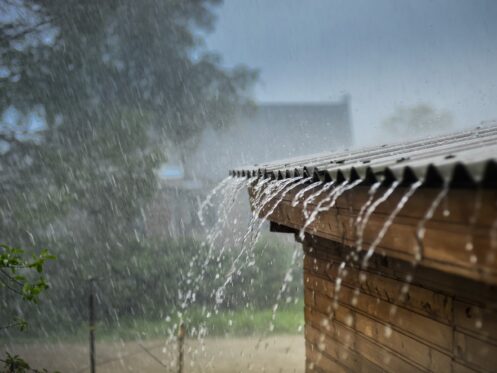The rainy season in Pompano Beach, FL, runs from late May to mid-October. Issues like blocked gutters, detached downspouts, lost shingles and torn flashing are some of the problems that residential roofs experience during these rainy months. Even if roofs aren’t affected by the strong winds and heavy precipitation, they’re still subject to the region’s high temperatures and salty, coastal air.
The good news is that you can increase your roof’s resilience before the rainy season arrives with the nine tips that follow.
1. Schedule a Pre-Season Roof Inspection
The best way to prepare your roof for prolonged bouts of rain is to schedule a comprehensive roof inspection. During these services, our roofers look for missing, bent, curled or lifted shingles. We also check for nail pops, damaged or blocked gutters, leaky roof protrusions and failed insulation.
Allowing roofers to catch and correct existing roofing issues before the storm season arrives will prevent them from spiraling out of control. It will also help you avoid water damage in the building’s interior, including:
- Wet, discolored ceilings
- Blistered and peeling paint
- Pervasive mold and mildew
- Damaged drywall, floors, and sub-floors
Every home in Pompano Beach should have a comprehensive roof inspection at least once each year. Scheduling yours in early May or sooner will prepare your roof for the challenges that lie ahead.
2. Clean Your Gutters
Maintaining clean gutters and downspouts will prevent pooling water in low-sloped areas, water damage to your roof’s substrate and interior leaks. Clean gutters and downspouts can reliably direct water away from your roof, keeping your home’s foundation intact.
By preventing standing water in low-sloped areas, clean gutters and downspouts also reduce the risk of rooftop pests. If you leave your roof’s drainage system filled with damp, decaying leaves and other organic materials, mosquitoes, flies, termites and other winged critters are drawn into the area.
You can keep your gutters clean throughout the rain season by installing gutter covers, gutter brushes or another gutter protection system. Many of these additions prevent twigs, branches, fruits and other debris from accumulating, so water can flow swiftly away from your roof.
Schedule a Gutter Inspection
Check your gutters and downspouts for stability and integrity. If strong winds from prior storms have loosened these features, you might have a gutter or downspout detach when the next storm hits. Have professional roofers inspect your gutters for leaks, corrosion and other wear to determine if it’s time for replacement.
3. Check for Adequate Attic Ventilation and Insulation
Optimizing your attic ventilation ahead of the rain season helps prevent problems with mildew and mold from developing and protects your indoor air quality (IAQ). We check attic ventilation during our comprehensive roof inspections. We look for evidence of existing leaks, find their points of entry and determine the best repair methods.
Optimizing airflow by improving your attic’s ventilation equalizes pressure. Lacking good airflow, strong winds can create major pressure differences between your attic space and the building exterior. This pressure could cause tears in flashing and other damage.
Make sure that your attic has enough insulation and that your insulating materials have a sufficiently high R-value. Quality insulation prevents extreme temperature fluctuations in the attic and assists with indoor moisture control. Reduced thermal cycling and lower humidity limit stress on roofing materials and slow the progression of ongoing wear.
4. Limb Your Trees
Strong winds and heavy rain can break off weak, dying and diseased limbs on trees that overhang your roof. Falling trees and tree branches can cause serious roofing damage, including total roof collapse. When limbing your trees, tree care experts can thin out heavy canopies. This keeps trees from being uprooted, so they don’t come crashing down.
5. Implement an Ongoing Pest Management Plan
Limbing damaged and low-hanging branches is also an effective way to prevent rooftop pests during the storm season. When the local weather is at its worst, climbing animals often transition from trees to roofs, attics and other accessible areas. By ensuring that low-hanging branches don’t create easy access points, you can avoid problems caused by pest nesting, gnawing, and chewing rodents, squirrels, and more.
You should also implement an ongoing pest management plan. This can include covering accessible food sources, eliminating standing bodies of water, sealing off potential entry points and keeping your gutters clean.
6. Inspect and Repair Roofing Protrusions
Your roof likely has multiple protrusions. These are elements that protrude from roofs, such as skylights, exhaust vents and chimneys. All roofing protrusions are surrounded by thin metal strips of flashing to prevent water entry. Check for loose, bent or missing flashing, and have it replaced.
If you have bulging or discolored ceilings below a roofing protrusion, leaky skylights or protrusions with rusted metal components, you need the help of a roofer to make roof repairs.
7. Take Care of Minor Roof Repairs
Although a single missing shingle might not seem like a big deal, leaving this problem unchecked could affect the integrity of your entire roofing system. Roofs have multiple layers. Each layer protects the layers that are beneath it from moisture damage.
When shingles fall off or fail, they expose moisture barriers to undue stress and wear. This can compromise the roofing substrate and, eventually, lead to issues with the roof’s decking. A missing shingle can also cause progressive wear on the existing shingles surrounding the affected area.
Repair all seemingly minor issues such as nail pops, damaged fascia and soffits and damaged shingles. This way, when the first storm of the season arrives, you’ll have a completely watertight barrier against the natural elements.
8. Fight the Effects of Salty, Coastal Air
Regular roof cleaning is a must for homeowners in Pompano Beach. Leaving clumps of leaves and other wet, windblown debris on your roof exposes shingles and other roofing materials to concentrated salt. With professional roof cleaning, you can eliminate problems like mold and algae and minimize the wear caused by your salty, coastal location.
9. Assess the Need for Roof Replacement
Sometimes, the only sure way to make a residential roof storm-ready is by replacing it. If your roof is nearing the end of its lifespan, comprehensive inspections, last-minute repairs and gutter cleaning will all fall short of making it watertight. You might need a new roof if your current one has:
- Separation at its valleys
- Widespread shingle loss
- Missing shingle granules
- Significant water damage around its protrusions
When roofers inspect your roof, they’ll check to see whether it’s firm and stable or springy and bouncy underfoot. When aging roofs have sustained prolonged and progressive moisture damage, their decking and underlying framing often develop wood rot.
We offer financing for new roofs for credit-qualified applicants via our third-party lending partners. We also provide free roof replacement estimates and a variety of affordable roofing types. Since 1986, we’ve proudly served Pompano Beach and the surrounding cities with expert roof repair, replacement and maintenance services.
If you need a comprehensive roofing inspection to prepare your home for the coming rain, contact Action Roofing today.




